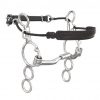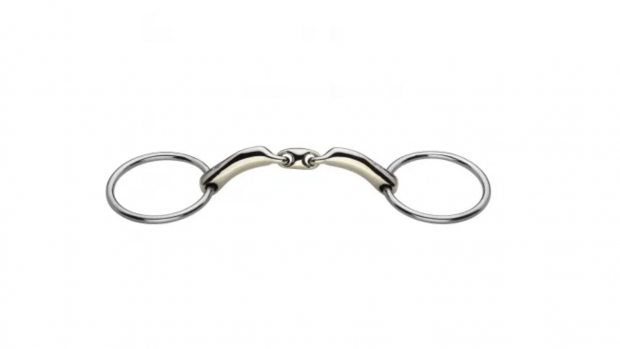How does the Myler combination bit work?
Contrary to its complex appearance, the Myler combination bit is said to be one of the kindest bits available. It spreads rein pressure over three to five areas, using a combination of the mouthpiece, curb strap and rope noseband.
Firstly, it acts on the nose, the poll and the back of the jaw. If a rider uses the reins more, the mouthpiece engages by moving up against a stop on the ring. This then acts on the tongue and bars, as in a normal mouthpiece.
“The Myler Combination bit is designed to distribute pressure but must be fitted correctly,” says bitting consultant Mary Wastie. “As the rider applies pressure to the reins, the horse initially feels the pressure on the front of the nose, followed by upper rear jaw, then on the poll and finally pressure inside the mouth.”
Eventer Louise Harwood uses the Myler combination bit on her gelding, Balladeer Miller Man (pictured).
“I tend to ride him in a hackamore for showjumping, but I was getting time faults for not going forwards enough,” she says. “The hackamore really relaxed him, so I wanted to use something with that same nose effect, but with a mouthpiece, too. In the Myler combination bit I can ride more forwards on him, and get rid of those annoying time faults!”
Not only can you decide how much pressure to exert and where, but you can also change the mouthpiece and shank length, depending on what you need.
However, this degree of freedom and flexibility has one drawback. Not all combinations are competition legal, so before you find a set-up that works, it’s important to check with the governing bodies whose rules you compete under.
“It is crucial to pick the correct mouthpiece for the stage of training the horse is at,” adds Mary.
“The combination worked well at Oasby in the showjumping, and I tackled the cross-country in it too,” says Louise. “I had control, but I need to try a longer shank for better steering. He can put his head up going cross-country, so I’m hoping it will help with that too.”
Vet nurse and amateur eventer, Alison Law, uses the Myler combination bit on her thoroughbred gelding. “I like the mouthpiece as it gives loads of tongue room, and I hadn’t found a bit that did that. I had a hunch that was the problem. The strength is extremely variable depending on the mouthpiece and length of shank chosen,” she says. “The one I use is very mild, but you can get stronger versions.”
What type of horse does it suit?
The Myler combination bit can work for most horses — from the just-backed to the schoolmaster. All five touchpoints engage and release pressure at the same time, creating the perfect pressure and release training system. As long as the rider relaxes their hand, the pressure goes.
Bitting consultant Hilary Vernon emphasises how vital it is for the rider to relax the hand. “The rider must have good hands that do not constantly hold too much contact, or the Myler combination will apply too much pressure to the horse’s face,” she says. “As the horse yields, so must the rider’s hands.”
The combination is particularly suited to horses used to facial pressure, but who haven’t yet worn a bit. For example, when backing a young horse who is used to signals from a headcollar or rope halter, the combination can be used to help transfer the aids.
“The Myler combination has more refined facial pressures to train with and is a good introduction to wearing a bit while still having those facial pressures,” says Mary.
Likewise, horses who are sensitive in the mouth are likely to find the pressure system more freeing.
Mary adds that the Myler combination is good for horses who have had a bad experience with a bit.
“It brings pressures to bear other than just the mouth, and allows the horse to gain confidence with mouth pressure again,” she says. “It’s also good for horses that have an unnaturally high head carriage on which nothing else has worked, to encourage them to lower the head.”
“I was having a lot of problems with control while jumping my sensitive thoroughbred,” says Alison.
“He seemed to really resent me taking a pull and would run through the contact with his head in the air. He was never strong any other time. The difference it made was unbelievable. It was like flicking a switch – he went from tense, rushing and almost panicky, to relaxed, rideable and making a beautiful shape over the fence.”
You might also be interested in:

Eggbutt snaffle or loose ring: what’s the difference?
Snaffles are the most widely used bits on the market, but what is the difference between a loose ring and

Choosing the right bit: would a Dutch gag suit my horse?

9 bits designed with young horses in mind

Choosing the right bit for your horse

Subscribe to Horse & Hound this spring for great savings
Horse & Hound magazine, out every Thursday, is packed with all the latest news and reports, as well as interviews, specials, nostalgia, vet and training advice. Find how you can enjoy the magazine delivered to your door every week, plus options to upgrade your subscription to access our online service that brings you breaking news and reports as well as other benefits.





